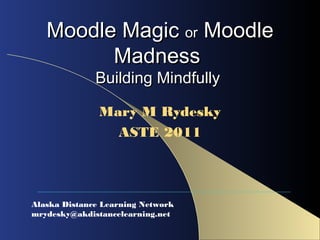ASTE_2011
- 1. Moodle MagicMoodle Magic oror MoodleMoodle MadnessMadness Building MindfullyBuilding Mindfully Mary M Rydesky ASTE 2011 Alaska Distance Learning Network mrydesky@akdistancelearning.net
- 2. Course DesignCourse Design Start with the end in mind What will change for learners? How will learners engage? How will you know âitâ happened? Alaska Distance Learning Network A timeless solutionâĶ& basic: Did you write a lesson plan?
- 3. Learner âStageâ is KeyLearner âStageâ is Key ïŽIntroductory ïŽIntermediate ïŽExpert Alaska Distance Learning Network More germane than âĒ V-A-K âĒ Left/right brain âĒ Generational
- 4. Save Time for LearnersSave Time for Learners Provide navigation clues Top outline section Identify course Checklist or syllabus Forum (s) Tools for use throughout Alaska Distance Learning Network
- 5. Sections/TopicsSections/Topics Relate to objectives content supports these tell objectives engage in activities How much material is too much? And how many sections is too many? What activities are best? Alaska Distance Learning Network
- 6. Activities & ResourcesActivities & Resources How do you pick? Alaska Distance Learning Network
- 7. Bloomâs SaysâĶBloomâs SaysâĶ Alaska Distance Learning Network Before weâĶ
- 8. Objective - ActionObjective - Action Alaska Distance Learning Network
- 9. Bloomâs & MoodleBloomâs & Moodle Alaska Distance Learning Network
- 10. Now MatchNow Match Alaska Distance Learning Network
- 11. What to Do?What to Do? ïŽRefine objectives ïŽDetermine assessment of each ïŽConsider learnerâs stage of learning ïŽPicks tools in support of these ïŽObserve, test, & revise Alaska Distance Learning Network Keep learning!
- 12. ResourcesResources Bloomâs http://edorigami.wikispaces.com/Bloom% 27s+and+ICT+tools Bowman, S. Preventing Death by Lecture. (2008) Bowperson Publishing. Clark, RC. Evidence-Based Training Methods. (2010) ASTD Press. Huggett, C. Virtual Training Basics. (2010) ASTD Press. Learning Styles Don't Exist http://www.youtube. Com/watch?v=sIv9rz2NTUk&feature=related Ward, D & Elkins, D. E-Learning Uncovered: From Concept to Execution. (2009). Alcorn, Ward. & Partners. Alaska Distance Learning Network
- 13. Contacting MeContacting Me ïŽMary M. Rydesky ïŽAlaska Distance Learning Network ïŽ mrydesky@akdistancelearning.net Alaska Distance Learning Network
Editor's Notes
- #2: Lillian Bernstein was a woman whose life was dedicate to training teachers. Lillian, by stature, made me look statuesque! She lived in Brooklyn, commuted to Manhattan, and prepared undergraduates to face NY public schools. And her impact on teaching made her as tall as the skyscrapers surrounding us. Lillian had a vision of teaching that was effective, engaging and enjoyable for both student AND teacher. And she identified a major adversary to reaching this end. Her message has stuck with me throughout years of teaching in K-12, higher learning, and workplace environments. What do you think she held up as the roadblock?
- #8: Bloom's Taxonomy in its various forms represents the process of learning. It has been simplified in some case like the Three Story Intellect (Oliver Wendell Holmes and Art Costa), but it still essentially represents how we learn.Before we can understand a concept we have to remember itBefore we can apply the concept we must understand itBefore we analyse it we must be able to apply itBefore we can evaluate its impact we must have analysed itBefore we can create we must have remembered, understood, applied, analysed, and evaluated.Some people may argue about that you do not require some of the stages for each and every task, action or process; some too may argue about the necessity to reach the creation level for all activities. This is the choice of the individual.













